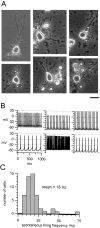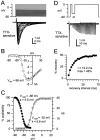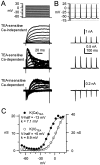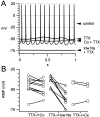Ionic currents and spontaneous firing in neurons isolated from the cerebellar nuclei
- PMID: 11124976
- PMCID: PMC6773000
- DOI: 10.1523/JNEUROSCI.20-24-09004.2000
Ionic currents and spontaneous firing in neurons isolated from the cerebellar nuclei
Abstract
Neurons of the cerebellar nuclei fire spontaneous action potentials both in vitro, with synaptic transmission blocked, and in vivo, in resting animals, despite ongoing inhibition from spontaneously active Purkinje neurons. We have studied the intrinsic currents of cerebellar nuclear neurons isolated from the mouse, with an interest in understanding how these currents generate spontaneous activity in the absence of synaptic input as well as how they allow firing to continue during basal levels of inhibition. Current-clamped isolated neurons fired regularly ( approximately 20 Hz), with shallow interspike hyperpolarizations (approximately -60 mV), much like neurons in more intact preparations. The spontaneous firing frequency lay in the middle of the dynamic range of the neurons and could be modulated up or down with small current injections. During step or action potential waveform voltage-clamp commands, the primary current active at interspike potentials was a tetrodotoxin-insensitive (TTX), cesium-insensitive, voltage-independent, cationic flux carried mainly by sodium ions. Although small, this cation current could depolarize neurons above threshold voltages. Voltage- and current-clamp recordings suggested a high level of inactivation of the TTX-sensitive transient sodium currents that supported action potentials. Blocking calcium currents terminated firing by preventing repolarization to normal interspike potentials, suggesting a significant role for K(Ca) currents. Potassium currents that flowed during action potential waveform voltage commands had high activation thresholds and were sensitive to 1 mm TEA. We propose that, after the decay of high-threshold potassium currents, the tonic cation current contributes strongly to the depolarization of neurons above threshold, thus maintaining the cycle of firing.
Figures











Similar articles
-
Ionic currents underlying spontaneous action potentials in isolated cerebellar Purkinje neurons.J Neurosci. 1999 Mar 1;19(5):1663-74. doi: 10.1523/JNEUROSCI.19-05-01663.1999. J Neurosci. 1999. PMID: 10024353 Free PMC article.
-
Mechanism of spontaneous firing in dorsomedial suprachiasmatic nucleus neurons.J Neurosci. 2004 Sep 15;24(37):7985-98. doi: 10.1523/JNEUROSCI.2146-04.2004. J Neurosci. 2004. PMID: 15371499 Free PMC article.
-
Ca currents activated by spontaneous firing and synaptic disinhibition in neurons of the cerebellar nuclei.J Neurosci. 2009 Aug 5;29(31):9826-38. doi: 10.1523/JNEUROSCI.2069-09.2009. J Neurosci. 2009. PMID: 19657035 Free PMC article.
-
Voltage-dependent conductances of solitary ganglion cells dissociated from the rat retina.J Physiol. 1987 Apr;385:361-91. doi: 10.1113/jphysiol.1987.sp016497. J Physiol. 1987. PMID: 2443669 Free PMC article. Review.
-
Synaptic inhibition, excitation, and plasticity in neurons of the cerebellar nuclei.Cerebellum. 2010 Mar;9(1):56-66. doi: 10.1007/s12311-009-0140-6. Cerebellum. 2010. PMID: 19847585 Free PMC article. Review.
Cited by
-
A model of on/off transitions in neurons of the deep cerebellar nuclei: deciphering the underlying ionic mechanisms.J Math Neurosci. 2021 Apr 1;11(1):7. doi: 10.1186/s13408-021-00105-3. J Math Neurosci. 2021. PMID: 33796951 Free PMC article.
-
Synchrony and neural coding in cerebellar circuits.Front Neural Circuits. 2012 Dec 11;6:97. doi: 10.3389/fncir.2012.00097. eCollection 2012. Front Neural Circuits. 2012. PMID: 23248585 Free PMC article.
-
Multisensory and unisensory neurons in ferret parietal cortex exhibit distinct functional properties.Eur J Neurosci. 2013 Mar;37(6):910-23. doi: 10.1111/ejn.12085. Epub 2012 Dec 19. Eur J Neurosci. 2013. PMID: 23279600 Free PMC article.
-
Persistent changes in the intrinsic excitability of rat deep cerebellar nuclear neurones induced by EPSP or IPSP bursts.J Physiol. 2004 Dec 15;561(Pt 3):703-19. doi: 10.1113/jphysiol.2004.071696. Epub 2004 Oct 21. J Physiol. 2004. PMID: 15498810 Free PMC article.
-
Spotlight on postural control in patients with multiple sclerosis.Degener Neurol Neuromuscul Dis. 2018 Apr 3;8:25-34. doi: 10.2147/DNND.S135755. eCollection 2018. Degener Neurol Neuromuscul Dis. 2018. PMID: 30050386 Free PMC article. Review.
References
-
- Aizenman CD, Linden DJ. Regulation of the rebound depolarization and spontaneous firing patterns of deep nuclear neurons in slices of rat cerebellum. J Neurophysiol. 1999;82:1697–1709. - PubMed
-
- Aizenman CD, Linden DJ. Rapid, synaptically driven increases in the intrinsic excitability of cerebellar deep nuclear neurons. Nat Neurosci. 2000;3:109–111. - PubMed
-
- Bayliss DA, Li Y-W, Talley EM. Effects of serotonin on caudal raphe neurons: activation of an inwardly rectifying potassium conductance. J Neurophysiol. 1997;77:1349–1361. - PubMed
-
- Bekkers JM. Distribution of slow AHP channels on hippocampal CA1 pyramidal neurons. J Neurophysiol. 2000;83:1756–1759. - PubMed
Publication types
MeSH terms
Substances
Grants and funding
LinkOut - more resources
Full Text Sources
Medical
